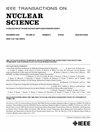应用于欧洲核子研究中心CMS/LHC定时探测器的差分前沿鉴别全电流模AFE暗噪声抑制
IF 1.9
3区 工程技术
Q3 ENGINEERING, ELECTRICAL & ELECTRONIC
引用次数: 0
摘要
在本文中,我们提出了一种全电流模式模拟前端(AFE)的高速率飞行时间(TOFHiR)前端应用专用集成电路(ASIC),设计用于新型桶形定时层(BTL)定时探测器,该探测器将在CERN升级的高亮度大型强子对撞机(HL-LHC)加速器的紧凑型介子螺线管(CMS)实验中使用。该AFE首次在硅中采用差分前沿识别(DLED)操作来抑制日益增加的辐射引起的暗噪声并稳定基线,从而使探测器在寿命开始(BoL)时的时间分辨率达到25 ps,在寿命结束(EoL)时的时间分辨率达到55 ps。本文提出的电流模式AFE对参数扩散和寄生不太敏感,因为信号流经低阻抗节点,因此也减少了信道间的不匹配。这个特性是非常重要的,因为TOFHiR是一个多通道ASIC, BTL将具有超过10k个TOFHiR ASIC,总计33万个通道。这些假设通过在100个模具和超过3100个通道上进行的测量得到了验证,这一成就是BTL探测器调试的关键。TOFHiR ASIC采用标准主流CMOS 130纳米技术设计,总晶片面积为8.5 × 5 mm2, 32通道,每通道功耗低于12 mW。到本文完成时,已经测量了5000多个TOFHiR asic,在1800个前端板上组装了3600个,200个烧坏的板已经运到CERN进行BTL探测器的组装。本文章由计算机程序翻译,如有差异,请以英文原文为准。
A Full Current-Mode AFE With Dark Noise Suppression Using Differential Leading-Edge Discrimination for the CMS/LHC Timing Detector at CERN
In this article, we present a full current-mode analog front-end (AFE) of the time-of-flight at high-rate (TOFHiR) front-end application specific integrated circuit (ASIC) designed for the new barrel timing layer (BTL) timing detector that will feature in the Compact Muon Solenoid (CMS) experiment of the upgraded high-luminosity Large Hadron Collider (HL-LHC) accelerator at CERN. The AFE features for the first time, in silicon, the differential leading-edge discrimination (DLED) operation to suppress the increasing radiation induced dark noise and stabilize the baseline, leading to a time resolution of 25 ps at the beginning-of-life (BoL) and 55 ps at the end-of-life (EoL) of the detector. The proposed current-mode AFE is less sensitive to parameter spread and parasitics since the signal flows through low impedance nodes, hence also reducing channel-to-channel mismatches. This feature is of utmost importance since TOFHiR is a multichannel ASIC and the BTL will feature over 10k TOFHiR ASICs totaling 330k channels. These assumptions were validated by measurements taken on 100 dies and more than 3100 channels, and this achievement was key to the commissioning of the BTL detector. The TOFHiR ASIC was designed in a standard mainstream CMOS 130-nm technology, has a total die area of $8.5\times 5$ mm2 and 32 channels, and dissipates less than 12 mW per channel. As this article was finalized more than 5000 TOFHiR ASICs have been measured, 3600 have been assembled in 1800 front-end boards, and 200 burned-in boards have already been shipped to CERN for assembling in the BTL detector.
求助全文
通过发布文献求助,成功后即可免费获取论文全文。
去求助
来源期刊

IEEE Transactions on Nuclear Science
工程技术-工程:电子与电气
CiteScore
3.70
自引率
27.80%
发文量
314
审稿时长
6.2 months
期刊介绍:
The IEEE Transactions on Nuclear Science is a publication of the IEEE Nuclear and Plasma Sciences Society. It is viewed as the primary source of technical information in many of the areas it covers. As judged by JCR impact factor, TNS consistently ranks in the top five journals in the category of Nuclear Science & Technology. It has one of the higher immediacy indices, indicating that the information it publishes is viewed as timely, and has a relatively long citation half-life, indicating that the published information also is viewed as valuable for a number of years.
The IEEE Transactions on Nuclear Science is published bimonthly. Its scope includes all aspects of the theory and application of nuclear science and engineering. It focuses on instrumentation for the detection and measurement of ionizing radiation; particle accelerators and their controls; nuclear medicine and its application; effects of radiation on materials, components, and systems; reactor instrumentation and controls; and measurement of radiation in space.
 求助内容:
求助内容: 应助结果提醒方式:
应助结果提醒方式:


